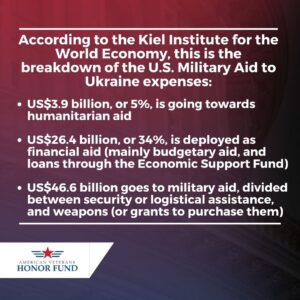In a world that’s fueled by money, financial aid constitutes one of the best tools to keep our country safe. The U.S. government has traditionally been very aware of the power of strategically-employed aid packages – and it has deployed this “soft weapon” generously.
The latest example? U.S. Military aid to Ukraine. For some, it’s part of our duty to help the downtrodden. For others, it’s a necessary investment in our future safety. But many question whether we’re sending the right type of aid, or if we should send any at all.
Should these funds be spent at home instead? Are we provoking an old enemy in an attempt to buy a new friend? It’s impossible to determine these things in a vacuum: to examine them, we need to go back to the basic and immutable numbers.
4 Facts About Our Ukrainian Aid Packages (And the Figures Behind it)
Throughout the past few decades, most aid packages were sent to countries around the Global South. And yet, since 2022, we’ve sent over US$75 billion, quickly placing Ukraine at the top of the recipient’s list. No European nation had needed such a massive amount of aid since the days of the Marshall Plan.
But that amount of money can buy lots of things. Here are four facts that shape military aid to Ukraine.
#1 – It is mostly going toward military
Ukraine is not just facing an invading army. It is also seeing its cities destroyed, its money-making industries flattened, and its population displaced. The war may have touched every aspect of daily life, and so have U.S. aid packages.
But let’s make no mistake: the money is largely going towards military efforts. According to the Kiel Institute for the World Economy, this is the breakdown of the expenses:
- US$3.9 billion, or 5%, is going towards humanitarian aid
- US$26.4 billion, or 34%, is deployed as financial aid (mainly budgetary aid, and loans through the Economic Support Fund)
- US$46.6 billion goes to military aid, divided between security or logistical assistance, and weapons (or grants to purchase them)
#2 – It’s a well-balanced combination of weapons
It’s also worth looking at the weapons we’ve sent so far. The full list is rather illustrative of the methods of modern war – as it includes a fairly balanced combination of machinery and guns.
In the news, tanks, armored carriers, and manned aircraft tend to overtake the headlines. But the bulk of the aid comes in large numbers of much more “modest” weapons.

The infantry arms and equipment sent so far include:
- 80,000 anti-armor systems
- 1,700 anti-aircraft systems
- 4,000 TOW missiles
- Explosives
- Claymore and anti-tank mines
- Night vision devices
- Medical supplies
- Protective field equipment against chemical biological, and nuclear attacks
In addition, we’ve sent a wide array of Howitzer artillery, mortar systems, ammunition, and precision-guided rockets. Finally, there’s an unspecified number of explosive, combat, and surveillance drones, as well as communication equipment.
#3 – It’s the bulk of our current aid recipients
The US$ 76 billion sent to Ukraine towers over all our other traditional aid recipients. For comparison, in 2020 we sent:
- US$4 billion to Afghanistan
- US$3.3 billion to Israel
- US$2.6 billion to Jordan
- US$1.5 billion to Egypt
To be fair, 2020 was hardly a “boiling point” for any of these countries. But even if we compare the amounts of aid sent at their respective peaks of strategic interest, Ukraine’s figures loom large.
As a percentage of our economy, Ukraine’s full bill accounts for 0.33% of our GDP. Meanwhile, in 1979, we sent the equivalent of 0.18% of our GDP to Israel. In 1964, just 0.15% was sent to Latin America.
#4 – We are not alone in the effort, but we are carrying most of the weight
The United States does not stand alone in helping Ukraine, or in acknowledging the dangers behind Putin’s policies. Other countries are also helping boost Ukraine’s military, even if not to the same extent.
Most military aid is coming from NATO countries, and almost all from wealthy democracies. But other smaller players, such as Colombia, Chile, Egypt, and Cambodia are contributing where they can – even if the latter is only assisting in landmine clearance operations.
It’s undeniable that this is largely our tab, however. Combined, EU institutions have only sent US$ 29 billion. The next largest contributor, the United Kingdom, only donated US$ 12 billion so far, out of which 7 billion went to military expenditure.
But we couldn’t close this analysis without a “special nomination” for Eastern European democracies. Although their economies are far smaller, if we look at aid as a share of their GDP, then the largest contributors are all in Ukraine’s neighborhood:
- Estonia has sent over 1.2% of its GDP
- Latvia, Lithuania, and Poland also sent over 0.8% of their GDP
- Slovakia, Denmark, Norway, and Finland all sent above 0.4% of their respective GDPs.
Will This Impact Our Local Vets?
Officially, any aid sent to Ukraine now is an investment to stop a legendary and pernicious enemy. The immediate expenditure may result in eventual cuts in local military spending – inclusive of V.A. benefits, healthcare for soldiers, or recruitment efforts. While we hope this doesn’t happen, we face this danger with just one hope: that our local boys won’t have to face the horrors of another protracted war in Europe.


